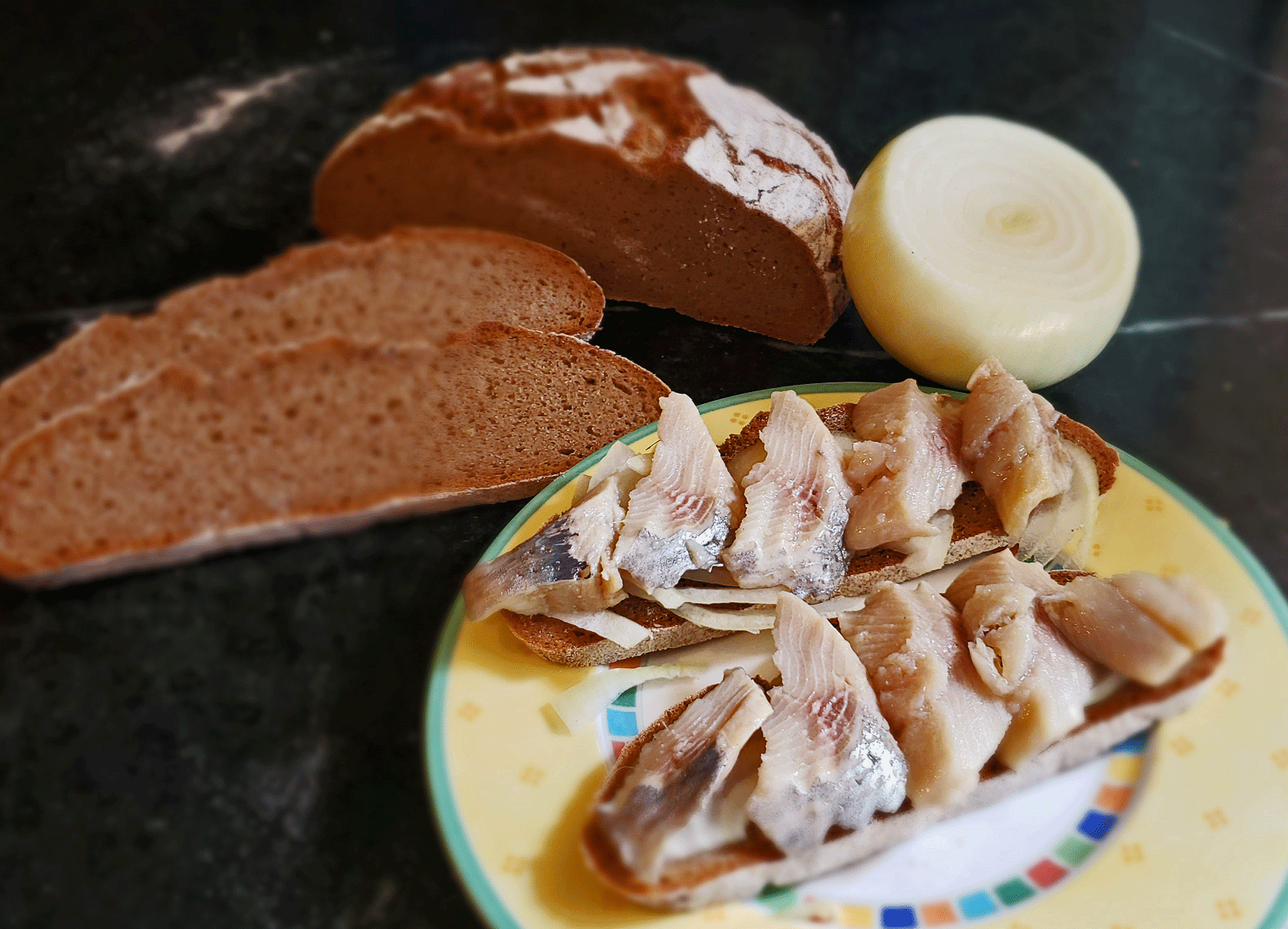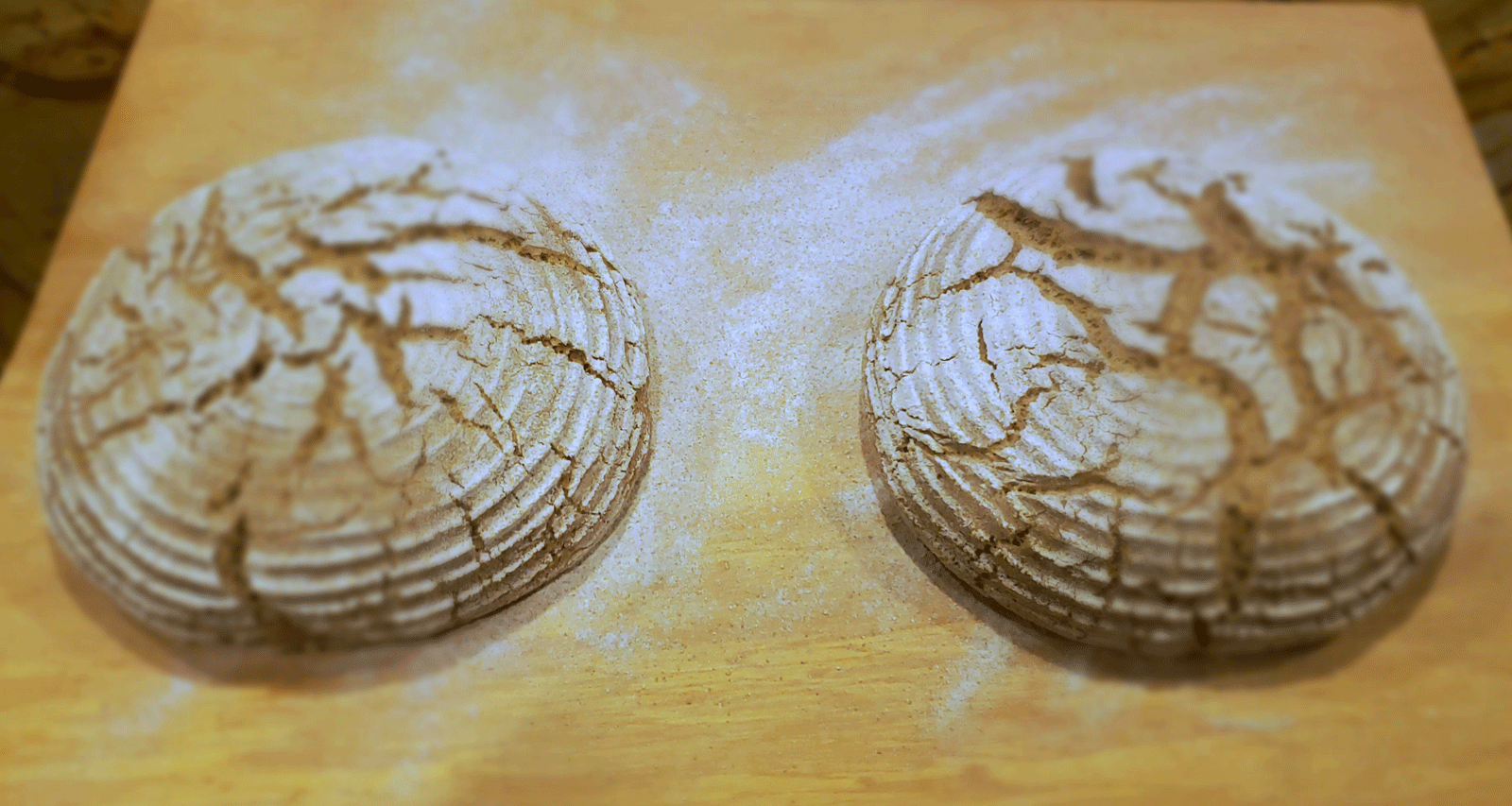|
Rye %: |
86% |
|
Stages: |
Stage 1 Rye Sponge, Stage 2 Rye Sponge, Wheat Sponge, Soaker, Final Dough |
|
Leaven: |
Rye sour culture |
|
Start to Finish: |
20-22 hours |
|
Hands-on Time: |
45-60 minutes |
|
Yield: |
Two 2 pound/900 gram loaves |
I found this bread in Dietmar Kappl’s’ ever-fascinating blog, homebaking.at and was immediately intrigued by its provenance – the region once known as Bohemia, and which today straddles the borders of three countries – Germany, Austria and the Czech Republic. By both its geography and methodology – multiple rye and wheat sponges, a stale bread soaker and the addition of a fragrant spice (fennel) – this Bohemian Forest Bread bears all the hallmarks of an Alpine/South-Central European rye bread.
Kappl’s formula calls for two types of rye flour: an Austrian Type 960, which is one grade darker than white rye – and which is virtually unobtainable in the US – and Austrian Type 2500, which is equivalent to Bay State’s dark rye flour. To make the formula more accessible to US bakers, I calculated the final ash content of Kappl’s flours and recalibrated the formula using more easily obtainable white rye and medium rye flours.
The end result? This is a lovely bread that offers everything I look for in a rye bread – a tender, moderately open crumb, chewy crust, the pronounced nutty flavor of the rye, underlain with the subtle fragrance of fennel; and a clean, mild sour finish. In all, it’s a versatile loaf that pairs nicely with all kinds of cheeses and charcuterie, as well as smoked and cured fish. I like it for breakfast, lightly coated with butter, then liberally covered with raw onion and Baltic herring – my idea of Jewish sushi.
Wheat Sponge (Day 1, Evening):
|
Ingredient |
Grams |
Ounces |
Baker’s |
|
60 |
2.10 |
100% |
|
|
Water |
50 |
1.75 |
83% |
|
Rye sour culture |
5 |
0.20 |
8% |
 Combine the sponge ingredients, cover and ferment at room temperature (70°F/21°C) for 18-20 hours. The sponge will be very bubbly, have tripled in volume and will have begun to collapse back on itself.
Combine the sponge ingredients, cover and ferment at room temperature (70°F/21°C) for 18-20 hours. The sponge will be very bubbly, have tripled in volume and will have begun to collapse back on itself.
Stage 1 Rye Sponge (Day 1, Evening):
|
Ingredient |
Grams |
Ounces |
Baker’s |
|
120 |
4.25 |
100% |
|
|
Water |
84 |
2.95 |
70% |
|
Rye sour culture |
10 |
0.35 |
8% |
 In the mixer bowl, mix the stage 1 ingredients by hand into a stiff sponge, cover and ferment at room temperature (70°F/21°C) 12-14 hours. The sponge will double in volume and show cracks and broken bubbles on the surface.
In the mixer bowl, mix the stage 1 ingredients by hand into a stiff sponge, cover and ferment at room temperature (70°F/21°C) 12-14 hours. The sponge will double in volume and show cracks and broken bubbles on the surface.
Stage 2 Rye Sponge (Day 2, Morning)
|
Ingredient |
Grams |
Ounces |
Baker’s |
|
240 |
8.45 |
100% |
|
|
Water |
276 |
9.75 |
115% |
|
Stage 1 rye sponge |
214 |
7.55 |
89% |
 Add the stage 2 ingredients to the stage 1 sponge, mix by hand, cover and ferment at room temperature (70°F/21°C) for 5-6 hours. The sponge will have doubled in volume and show cracks and/or broken bubbles on the surface.
Add the stage 2 ingredients to the stage 1 sponge, mix by hand, cover and ferment at room temperature (70°F/21°C) for 5-6 hours. The sponge will have doubled in volume and show cracks and/or broken bubbles on the surface.
Soaker (Day 2, Morning)
|
Ingredient |
Grams |
Ounces |
Baker’s |
|
Stale rye bread |
50 |
1.75 |
100% |
|
Warm (110°F/43°C) water |
400 |
14.10 |
800% |
 Break the stale rye bread into small pieces and combine with the water in a separate container. Let stand until the bread has absorbed most or all of the water and breaks up easily.
Break the stale rye bread into small pieces and combine with the water in a separate container. Let stand until the bread has absorbed most or all of the water and breaks up easily.
Final Dough (Day 2, Afternoon):
|
Ingredient |
Grams |
Ounces |
|
Wheat sponge |
115 |
4.00 |
|
Stage 2 rye sponge |
730 |
25.75 |
|
Soaker |
450 |
15.85 |
|
650 |
22.95 |
|
|
100 |
3.55 |
|
|
Water |
400 |
14.10 |
|
Salt |
25 |
0.90 |
|
Fennel seed, ground |
8 |
0.30 |
 In the mixer bowl, combine the final dough ingredients and use the dough hook to mix at low (KA2) speed, scraping the bowl as needed, until fully blended into a firm dough that leaves the sides of the bowl, 7-8 minutes.
In the mixer bowl, combine the final dough ingredients and use the dough hook to mix at low (KA2) speed, scraping the bowl as needed, until fully blended into a firm dough that leaves the sides of the bowl, 7-8 minutes.
Cover the bowl and ferment at room temperature until the dough doubles in volume and shows broken bubbles on the surface, 60-75 minutes.
Turn the dough onto a well-floured work surface and divide it into two pieces, each weighing about 2¼ lb/1,000 g. Use floured hands to shape each piece into a boule and place seam side down into a floured brotform or cloth-lined proofing basket. Cover loosely with a cloth or plastic wrap and proof at room temperature until the dough has visibly expanded and shows cracks, about 30 minutes.
Turn the loaves onto a well-floured peel, if using a baking stone, or parchment-lined sheet pan and proof at room temperature for an additional 15-20 minutes.
Preheat the oven to 485°F/250°C with the baking surface in the middle and a steam pan on a lower shelf. Bake with steam for 3-5 minutes, then remove the steam pan. Continue baking at 485°F/250°C for an additional 10 minutes.
Reduce the oven temperature to 395°F/200°C and bake until the loaves thump when tapped with a finger and the internal temperature is at least 203°F/95°C, 50-60 minutes. Transfer to a rack and cool thoroughly before slicing.
Baker’s Percentages:
|
Ingredient |
g |
% |
|
TOTAL FLOUR |
1,170 |
100.00% |
|
Medium rye flour |
890 |
76.07% |
|
White rye flour |
120 |
10.26% |
|
Bread flour |
160 |
13.68% |
|
Water |
810 |
69.23% |
|
Salt |
25 |
2.14% |
|
Rye sour culture |
15 |
1.28% |
|
Stale bread |
50 |
4.27% |
|
Fennel seed |
8 |
0.68% |
|
TOTAL FORMULA |
2,078 |
177.61% |
|
Flour Prefermented |
420 |
35.90% |




Karin Anderson
February 8, 2020Praise to you, Stanley, for “translating” the specialty European rye flour types to some we can get here in the US.
Dietmar has a great blog, I tried several of his loaves. And I prefer the “Jewish Sushi” anytime
Karin Anderson
February 8, 2020I just saw what Autocorrect did to my website URL
Chris
March 27, 2020Great knowledge shared, grateful Joe Beddia (awesome pizza master)mentioned you and the supplies that are offered. But feeling a bit strange, what is rye sour culture? Different from rye starter?
Stanley Ginsberg
May 6, 2020same thing, different name.
FL
September 9, 2020I need some help please with flours troubleshooting. Since I did not have medium rye I used dark rye from Whole Foods(I buy it from their bulk section) – 60% and Polish white rye bread flour (t-720) I buy it from the local polish store- 40% to create medium flour. My bread flour is 365 brand from whole foods. The final dough was way too liquidy and I had about 150 gr of water still left. I also had to add about 4 large tblspoons of dark rye to make a dough that can be somewhat worked with. My understanding was that I need to mix dark and white rye 50/50 to get to medium. I mixed 60/40 to error on the side of dark flour and final dough was still way too liquid. The crust also turned out super weird. However bread turned out tasty and with a good crumb, however it was not what it was supposed to be. I made a few other 100% rye breads using recipes from here and I know that it should have turned out differently. Also, what is the definition of a stale bread? Does the bread have to be 100% dry? I used truly stale bread (about 10 days old) and after adding water it was way toooo much water not like it is on the picture. I had to add another 50 gr of the bread and still had about a cup of water left that was not absorbed. I think the main issue is the flour mix, but looking for reccomendations
Stanley Ginsberg
January 17, 2021At 70% hydration, you shouldn’t be having that problem. Have you confirmed your water quantities? As for stale bread, I let mine dry out thoroughly before storing it in plastic.
Rob
April 20, 2021Just baked this. Fantastic flavor. But, like FL, above, I had a problem. The stale bread didn’t absorb the full 400 g of water. I followed the formula, which called for 450 g of soaker, and so I added all the soggy bread and all the water from the soaker to the final dough. Then, without thinking, I added the full 400g of additional water the recipe calls for. This overhydrated the dough so that it lost structure and flattened frisbee-like during the final proof. The bottom of each loaf thumped tautly when pulled from the oven last night. The crumb looks excellent this morning — but it’s overly moist and a little gummy. Perhaps after another 24 hours of rest, the second loaf will be better. But I think the problem is that the dough didn’t need all the extra water. If I make it again — and I might, as the flavor really is wonderful — I’d add the full soaker water and go easy on the additional water in the final mix.
Rob
April 20, 2021BTW: I just did the math and if you include the 400 g of soaker water in the bakers percentage calculations lower down in the recipe (which, I admit, I did not look at before baking), the dough would be 100% hydration.
Alex Larkin
April 20, 2021I made this loaf a couple of weeks back and had the same issue. The actual aggregated water volume is 1210g, and not 810g as stated in the final percentages. I added additional flour at the final dough stage to bring the water percentage back in line with that stated in the final table. The final loaf was reasonably well risen and had a good flavour. I will definitely be making this loaf again but will miss out the final 400g of water at the final dough stage.
Alex Larkin
April 20, 2021Water is slight over 100% –
__50g Wheat sponge –
__84g Rye sponge 1
_276g Rey sponge 2
_400g Soaker
_400g Final dough
1210g Total